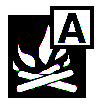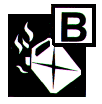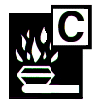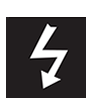Fire Extinguishers – Classes, Colour Coding, Rating, Location and Maintenance
Classification of Fires
Fires are classified in six groups A, B, C, D, F and electrical:
- Class A fires – are fires involving organic solids like paper, wood, etc
- Class B fires – are fires involving flammable liquids
- Class C fires – are fires involving flammable gasses
- Class D fires – are fires involving burning metals (eg aluminium swarf)
- Class F fires – are fires involving fats such as used in deep fat fryers
- Electrical fires (the letter E is not used. Instead the symbol of an electric spark is displayed) – are fires caused by electrical equipment






Electrical Fires
Electrical fires are not given their own full class, as they can fall into any of the classifications. After all it is not the electricity burning but surrounding material that has been set alight by the electric current.
The first step when fighting a fire caused by electricity is to switch the equipment off. In addition, any water based extinguishers used on electrical equipment should be dielectrically tested and certified to ensure that you can extinguish the fire safely, even if the power supply is left on. It must be remembered that certain electrical apparatus maintain a lethal charge for some time after they have been switched off.
Colour coding of Extinguishers
The type of extinguisher is identified by a colour coding as indicated below. The old fire extinguishers standard required the whole of the body of the extinguisher to be painted the appropriate colour. You will find these extinguishers in many premises and these are still legal, you do not need to change them unless the extinguisher is defective and needs to be replaced. New extinguishers are manufactured to the standard BS EN 3.
- Water extinguishers are coloured signal red.
- Other extinguishers will be predominantly signal red with a label, band or circle covering at least 5% of the surface area of the extinguisher in a second colour indicating the contents of the extinguisher.
Fire extinguishers colour-coded green are vapourising liquids (Halons) and have been illegal, with some exceptions like aircraft and the military, since the end of 2003 as the result of the Montreal protocol. They need to be disposed of legally, for more information go to Phasing out Halons in portable fire extinguishers.
The indicating colour always indicates the type of extinguisher medium.
| Type | Old Code | BS EN 3 Colour Code | Fire Class |
|---|---|---|---|
| Water | Signal Red | Signal Red | A |
| Water Mist | White and Red | White and Red | A, (suitable for B and C, although without formal marking). Suitable for electrical risk if dielectrically tested and deploying de-ionised water. If certified suitable for small F fires |
| Foam | Cream | Red with a cream panel above the operating instructions | A, B, electrical if dielectrically tested |
| Dry Powder | French Blue | Red with a blue panel above the operating instructions | A, B, C, electrical |
| Carbon Dioxide | Black | Red with a black panel above the operating instructions | B, electrical |
| Halon | Emerald Green | No longer produced – illegal in the UK | A |
| Wet Chemical | Not in use | Red with a yellow panel above the operating instructions | A, F, some are also suitable for B class fires |
| Specialist Powder | French Blue | Red with a blue panel above the operating instructions | D |
Not using the above colour coding means the fire extinguisher does not conform to the British standard and therefore cannot display the Kitemark. If a specific piece of legislation requires them to conform to the British Standard, then they would be unsuitable. In the case of the The Regulatory Reform (Fire Safety) Order 2005 this order does not require portable fire extinguishers to conform to the British Standard.
Therefore they are legal in premises covered by this order, however the DCLG guidance on the RR(FS)O does recommend they should conform to the British Standards which leaves the Responsible Person in a dilemma. Wherever reasonably possible, it is best practice to select extinguishers which conform to BS EN 3
Fire Rating
All extinguishers capable of extinguishing class A, B or F fires carry a fire rating which is indicated by a number and letter (eg 13A, 55B). The number is indicating the size of fire it can extinguish under test conditions. The larger the number, the larger the fire it can extinguish. The letter indicates the fire classification as above. Class C, D and the electrical symbol do not carry a numerical rating.
All extinguishers capable of extinguishing class F fires have a rating based on 4 benchmark tests using 5, 15, 25 and 75 litres of sunflower oil. The oil is heated to auto-ignition and allowed to pre-burn for 2 minutes. The fire is then extinguished and no re-ignition shall occur within 10 minutes of extinguishing the fire.
For a fuller explanation, go to Portable Fire Extinguisher Guide and for a full explanation check out the latest edition of BS EN 3-7
Chosing Fire Extinguishers
For a kitchen at home, a water mist extinguisher using de-ionised water and a fire blanket would be considered satisfactory for most situations. Alternatively, a wet chemical extinguisher can be a solution. A water mist extinguisher, with its broad fire fighting capability across most fire risks is also suitable for the rest of the house. Remember to tackle only small fires, if in doubt, get out and always call the fire service out.
Commercial and public organisations need to have a survey conducted to ascertain the number and type of extinguishers that are required. The ratings of the extinguishers are then used to calculate the number and type of extinguishers required. We recommend that you check out any service company on Trustpilot, as there are many untrustworthy companies in the industry.
The following factors should also be considered when siting fire extinguishers:
- Extinguishers should normally be sited on escape routes on all floors at what is called ‘fire points’.
- They should be fixed in a location where the extinguisher can be reached quickly. The best place is near a door leading to a place of safety or near a specific fire risk.
- They should be fixed where they can be easily seen. Fixing them inside cupboards or behind doors will waste valuable time if a fire breaks out.
- Do not place them over cookers or heaters or in places of extreme temperatures, hot or cold.
- Extinguishers should be fixed at an elevated height, so that the carrying handle is 1m from the floor for heavier units (heavier than 4kg) and 1.5m for smaller units.
- Extinguishers should be within reasonable distance from any fire risk:
- Class A: 30m
- Class B: 10m
- Class C: 30m
- Class D: case-by-case basis, by expert advice
- Class F: 10m
- If you have to travel through doorways, the maximum travel distances need to be reduced.
- The method of operation should be similar for all extinguishers, where possible.
- The occupiers should be capable of handling all the types and sizes recommended.
- Where different types of extinguishers for different risk types are sited together they must be properly labelled to prevent confusion.
- Extinguishers should be fitted with suitable jet or spray nozzles or flexible hoses to suit the risk involved.
Additional References can be found in BS 5306 Part 8.
Maintenance
Extinguishers in commercial or public buildings should be visually inspected monthly for damage or pressure loss and should be serviced in line with the manufacturer’s instructions or to BS 5306-3. Water, foam and powder extinguishers have to be discharged and refilled every five years. CO2 extinguishers must be refurbished after ten years. One exception, however, are the kitemarked P50 servicing-free extinguishers which only need refurbishment after ten years and do not require maintenance within the ten years (other than the monthly visual inspection and a recorded yearly visual inspection by the owners).
In general, the manufacturer’s instructions will tell you what you need to do to keep your extinguisher in good working order. After an extinguisher has been used, even if only partially, it must be recharged according to the manufacturer’s instructions. See this guide about fire extinguisher maintenance for further details.
Service-Free Extinguishers:
BS 5306-3 and most extinguisher manufacturers recommend yearly servicing by an engineer and the refilling of foam, water and powder extinguishers every five years. One exception are the UK manufactured P50 service-free extinguishers which are guaranteed for ten years and which do not require maintenance by an external technician over the ten year period. In actual fact, these extinguishers lose their warranty if any attempt is made to open or modify the unit. They still require a recorded annual visual inspection by the owners, though. The visual inspection consists of checking the pressure gauges, checking the extinguisher for damage and checking the manufacture date of the extinguisher and recording the results in a fire safety logbook and on the back of the extinguisher. Insurance companies accept these extinguishers but should be notified of the change in the maintenance procedure once you have installed P50 extinguishers.
As there is no visit by an extinguisher specialist for 10 years, the installation of service-free extinguishers should always include first of all a site survey to ensure the right type of extinguisher is selected, followed by the actual install and subsequent training of the customer by the technician to ensure the customer fully understands the product. The purchase of a P50 extinguishers should always include a survey, the installation, the commissioning, the training and certification for the training.
Purchasing Portable Fire Extinguishers
When purchasing fire extinguishers always ensure they meet the requirements of the appropriate British Standard. Look for the kitemark or LPCB mark to prove correct certification. If the extinguishers are for commercial or public buildings they will need to be certified on-site AFTER the delivery. Surfing the internet will produce many suppliers but always use a company that sells extinguishers meeting the appropriate British Standard and make sure that any supplier offers ON SITE commissioning (certification) or installation carried out by an engineer AT YOUR SITE. Be careful, as some internet companies offer certification prior to delivery, which is not acceptable, as extinguishers could get damaged in transit.
If you require any further information about the type of fire extinguishers you should buy, ask your local fire service. They will be glad to help you and their expert advice is free of charge. They will also be able to provide you with general fire safety advice.
Which Portable Fire Extinguishers to Use
| Water | Water Mist, dielectrically tested | Foam | ABC Dry Powder | Specialist Powder | CO2 Gas | Wet Chemical | |
|---|---|---|---|---|---|---|---|
 Fires involving freely burning materials. For example wood, paper, textiles and other carbonaceous materials. |
 |
 |
 |
 |
|||
 Fires involving flammable liquids. For example petrol and spirits. NOT ALCOHOL OR COOKING OIL. |
 |
 |
 |
 |
 |
||
 Fires involving flammable gasses. For example propane and butane. |
 |
 |
|||||
 Fires involving flammable metals. For example magnesium and lithium. |
 |
||||||
 Fires involving electrical equipment. For example photocopiers, fax machines and computers. |
 |
 |
 |
||||
 Fires involving cooking oil and fat. For example olive oil, maize oil, lard and butter. |
 |
Before you tackle a fire
Many people put out small fires quite safely. However, some people die or are injured by tackling a fire which is beyond their capabilities. Here is a simple fire code to help you decide whether to put out or get out.
- Only tackle a fire in its very early stages
- Always put your own and other peoples safety first
- On discovering the fire, immediately raise an alarm
- Make sure you can escape if you need to and never let a fire block your exit
- If you cannot put out the fire or if the extinguisher becomes empty, get out and get everyone else out of the building immediately, closing all doors behind you as you go. Then ensure the fire brigade has been called
Further information
Information on Types, Colours and Use of Portable Fire Extinguishers
Information about Fire Extinguisher and Fire Extinguisher Maintenance
Fire Extinguishers for Electrical Fires
Portable Fire Extinguisher Guide.
Determining the Age of Portable Extinguishers
Comparison of cartridge extinguishers versus stored pressure extinguishers
Categories:Fire Safety Equipment
March 15, 2011[Last updated: November 10, 2023]
Comments are closed here.